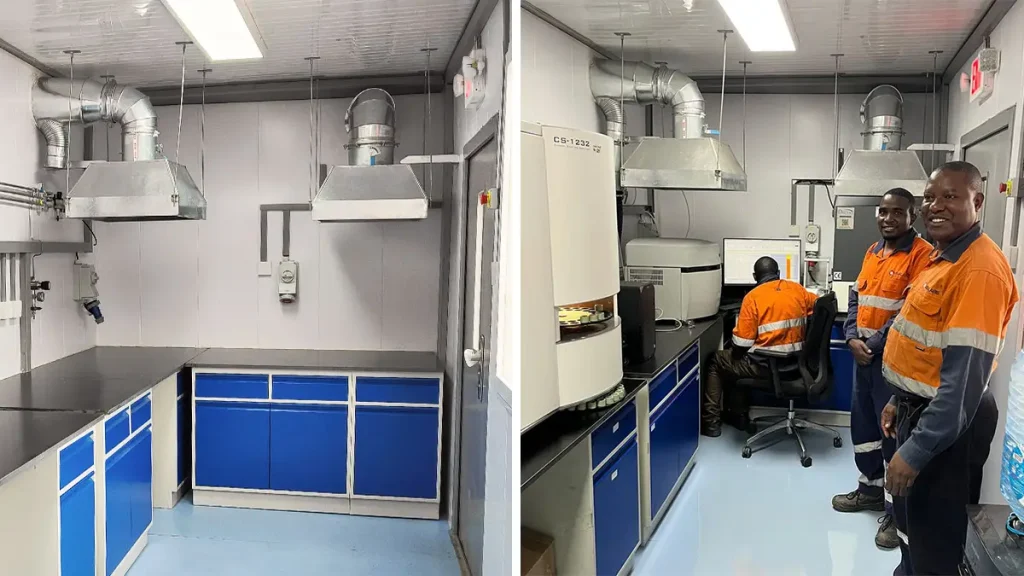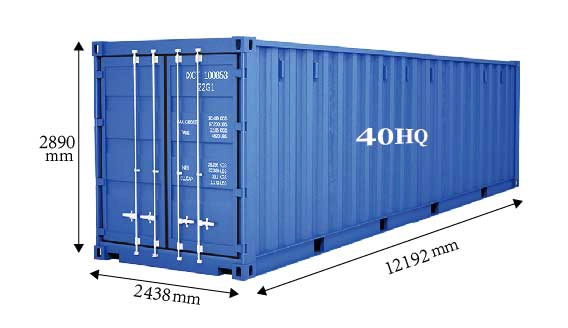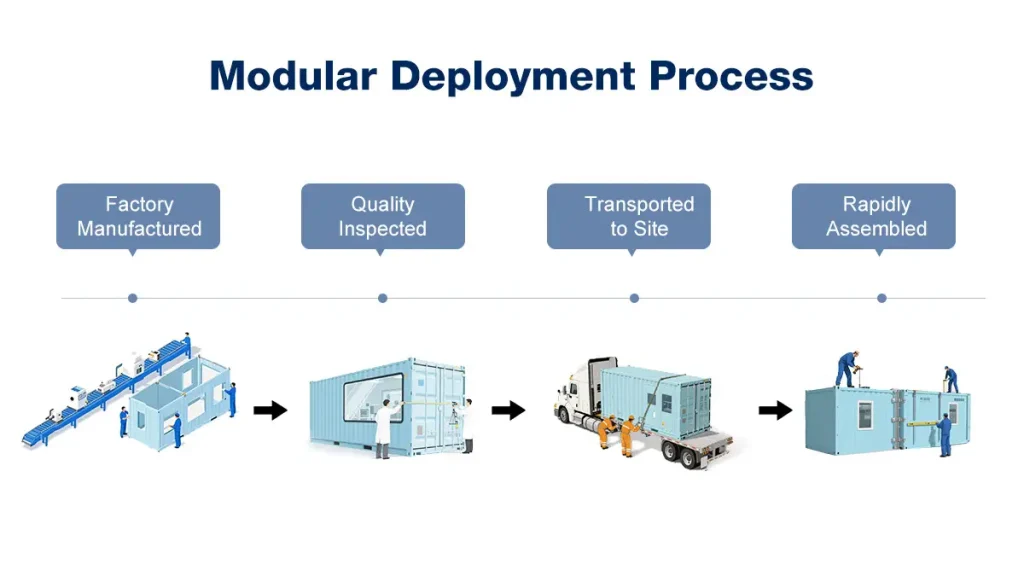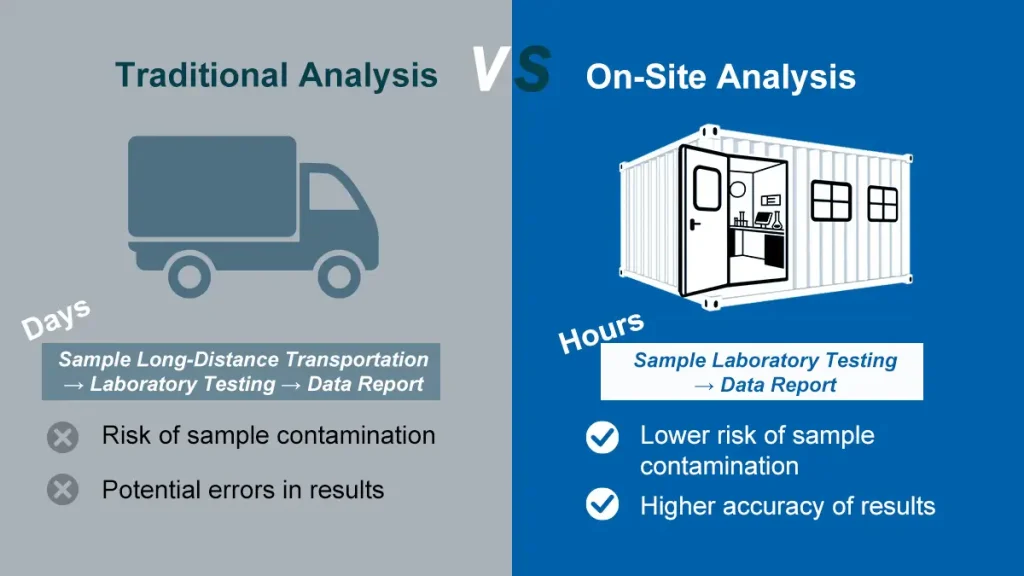Executive Summary: Bridging the Gap Between Remote Mines and Real-Time Data Through Strategic Laboratory Design
The global mobile laboratory market is experiencing rapid growth, projected to expand from $2.3 billion in 2024 to $4.5 billion by 2032. This growth is primarily driven by the mining industry’s urgent need for operational efficiency, rapid response capabilities, and enhanced safety in remote locations. Traditional fixed laboratory models, with their inherent logistical delays and slow decision-making processes, can no longer meet the fast-paced demands of modern mining operations.
This solution provides a comprehensive design philosophy for containerized laboratories. Built within ISO standard shipping containers, these laboratories are self-contained, rugged, and mobile. Through “plug-and-play” modular design, optimized space utilization, and integrated high-standard safety systems, we offer revolutionary solutions for mining clients. This approach not only delivers the flexibility and cost-effectiveness of on-site laboratories but, more importantly, provides real-time, high-quality analytical data to support precision decision-making in modern mining operations.
Our ultimate goal is to transform an ordinary shipping container into the “central data processing hub” of mining projects, enabling real-time production optimization, enhancing operational efficiency, and ensuring data authority and reliability through compliance with international standards.
Industry Pain Points and Solutions: Tailored for Remote Mining Operations
In the challenging field of mineral exploration and extraction, traditional fixed laboratories face a series of severe practical problems. Containerized laboratories, as an innovative model that deploys advanced analytical capabilities directly to operational sites, provide ideal solutions to these industry pain points.
Industry Pain Point Analysis
- Logistical Bottlenecks in Remote Areas: High-value mineral resources are often located in remote areas with poor transportation access. Long-distance transportation of samples from mining sites to external laboratories is not only costly and time-consuming but may also lead to sample contamination or deterioration during transport, affecting the accuracy of analytical results.
- Severe Decision-Making Delays: Relying on external laboratories for sample analysis typically requires several weeks to obtain results. This delayed data feedback severely impacts the efficiency of exploration and production decisions, potentially causing untimely production parameter adjustments, missed optimization opportunities, and unnecessary economic losses.
- High Infrastructure Costs and Complexity: Building a permanent traditional laboratory requires substantial initial capital investment, lengthy construction periods, and complex civil engineering work. For mining companies with medium to short-term projects or those in exploration phases, this represents a significant financial burden.
DECENT Containerized Laboratory Solutions
Containerized laboratories, with their unique design, precisely address the above pain points, providing mining clients with efficient, economical, and flexible on-site analytical solutions.
- Exceptional Mobility and Rapid Deployment Capabilities: Unlike permanent structures, containerized laboratories are “plug-and-play” standardized products that can be prefabricated and commissioned in factories, then rapidly transported to any remote or harsh operational site via truck, ship, or aircraft. This significantly reduces construction timelines, eliminates large-scale on-site construction, and provides tremendous convenience for exploration projects and pilot plants.
- Significant Cost-Effectiveness and Flexibility:Compared to building and maintaining traditional laboratories, containerized laboratories have lower initial investment and operational costs. Their modular design not only facilitates standardized production in factory environments, thereby reducing costs, but also means laboratories can be expanded or reconfigured at any time according to changing project requirements. For example, when sample processing volumes increase, new functional modules can be conveniently added to achieve seamless upgrades.
- Optimized Workflows and Enhanced Safety: Deploying laboratories directly to mining sites enables immediate on-site sample analysis, optimizing the entire workflow. Real-time data feedback allows production teams to quickly adjust process parameters, improving production efficiency. Meanwhile, the sealed structure of containers provides a safe, controlled working environment for laboratory personnel, with built-in professional safety systems effectively addressing various potential risks and ensuring personnel and equipment safety.
Case Study: Successful Implementation at: Tanzania Graphite Project
- Background: A client’s new mining site was located in a remote area of Tanzania with rough roads and frequent traffic interruptions during the rainy season.
- Original Process: Samples needed to be sent to laboratories in Dar es Salaam for analysis, with the entire cycle taking 3-4 weeks. The production team, unable to obtain timely data, could only conduct “blind guessing” production, resulting in severe fluctuations in graphite recovery rates and potential revenue losses of up to 15%.
- DECENT Solution:We deployed a 40-foot containerized laboratory integrating sample preparation and AAS (Atomic Absorption Spectroscopy) analysis modules. Within just one month of operation, graphite recovery rates stabilized above 92%. Through real-time data optimization, high-grade graphite production successfully increased by 22%. The project manager commented: “This is not just a laboratory; it has become the ‘central data processing hub’ that guides our production.”

Design Core: Transformation from Standard Container to Professional Laboratory
The design of containerized laboratories begins with a standard ISO (International Organization for Standardization) shipping container, typically selecting 20-foot (6-meter) or 40-foot (12-meter) specifications. We choose this standardized carrier precisely for its inherent durability and robust construction, capable of withstanding harsh transportation and natural environmental challenges.
The entire transformation process involves a series of carefully planned professional modifications:
- Structural Reinforcement: To bear the weight of heavy laboratory equipment and stresses from frequent relocations, we perform necessary structural reinforcement of the container framework.
- Environmental Control:Mining site climate conditions are often extremely harsh. Therefore, we provide professional thermal insulation treatment for the container body and equip it with high-performance HVAC (Heating, Ventilation, and Air Conditioning) systems to ensure constant temperature and humidity inside the laboratory, which is crucial for precise instrument operation.
- Functional Integration:We completely integrate all necessary supporting facilities, including electrical, water supply and drainage, and waste liquid treatment systems, inside the container. This includes equipping professional electrical control cabinets and providing corresponding power interfaces according to equipment requirements (such as 380V/220V 50Hz). Many laboratories are also designed with backup generator sets to ensure independent power supply in remote areas. For example, certain laboratories are configured with two 200-amp power supplies, providing a total of 400 amps/240V.
An important lesson learned is that traditional laboratory design drawings often differ from actual construction. Therefore, it is essential to obtain and verify as-built drawings of the container before design begins. Additionally, designers must adequately reserve space above the ceiling to accommodate complex ventilation ducts and HVAC systems. This is crucial because very few engineers and construction companies have experience handling such complex laboratory ventilation systems, especially those requiring multiple complete air changes per hour.
Key Data:Through on-site analysis, sample testing cycles have been dramatically reduced from the traditional average of 21 days to 4 hours, enabling mining engineers to adjust production parameters based on same-day data.

Core Principle: Modular Design Philosophy
Modularity is the soul of containerized laboratory design. It means that various functional units or entire container units of the laboratory are prefabricated in controlled factory environments. This model brings incomparable advantages to mining companies:
- Rapid Production: As prefabricated products, laboratories can complete most manufacturing and commissioning work in factories, requiring only simple installation and connection upon arrival at sites, typically becoming operational within one week, greatly shortening project timelines.
- Flexible Expansion: The modular characteristics make laboratory expansion exceptionally simple. When business volumes increase or new analytical processes need to be introduced, corresponding functional modules can simply be added to easily meet demands.
- High Customization:Design solutions can be completely customized according to specific client requirements. A single container can be divided into different functional areas, and multiple containers can be combined into a large comprehensive analytical center, such as mobile sample preparation rooms or independent fire assay chambers. A valuable lesson learned is that laboratory personnel usage habits may change over time. Therefore, designs must be forward-looking, ensuring that workspace layouts can be conveniently adjusted without affecting core facilities (such as dust removal, ventilation, electrical, and lighting systems).
Key Data:By adopting containerized laboratories, clients can save over $180,000 annually in external testing and logistics costs, with an estimated project investment payback period of less than 14 months.

Space Layout: Ingenious Design Within Limited Space
Achieving efficient, safe, and comfortable working environments within the limited space of shipping containers presents enormous challenges for designers. Our design focus is on maximizing the utilization of every inch of space while ensuring smooth workflows and personnel safety.
- Professional Functional Zoning:To prevent cross-contamination and ensure safety, we divide internal spaces into different functional areas, such as crushing zones, sample preparation rooms, high-temperature furnace rooms, and analytical rooms.
- Ergonomic Workstations: We select durable laboratory benches, chairs, and compact storage cabinets to maximize workspace. Workflows are carefully designed to ensure technicians can smoothly and efficiently complete various operations.
- Rational Equipment Layout:We perform precise positioning based on the dimensions and operational requirements of core equipment (such as jaw crushers, pulverizers, and high-temperature furnaces) to ensure optimal performance and convenient maintenance.
A frequently overlooked design consideration is that adequate passages must be reserved for the entry and exit of large equipment. In containerized laboratories, this requires thorough advance planning of entrances and internal corridors. Additionally, although we aim to fully utilize every inch of space, sometimes preserving some blank areas can actually reduce unnecessary movement of personnel and samples, thereby improving efficiency. Considering that equipment like crushers and pulverizers generate significant noise, designs must also fully consider noise reduction measures to ensure a safe and comfortable working environment.

Safety Assurance: Comprehensive Protection Systems
Safety is the top priority in any laboratory design, especially in sealed, mobile environments like containers. An important concept is that laboratory safety depends not only on design but also on personnel operating habits. Therefore, we integrate a complete safety system during the design phase to protect personnel and equipment safety. These systems typically meet or exceed international standards, such as those from the National Fire Protection Association (NFPA) or the International Organization for Standardization (ISO).
- Ventilation and Air Quality:To effectively handle dust generated from sample preparation and harmful gases from chemical analysis, laboratories are equipped with advanced ventilation systems, including negative pressure systems and High-Efficiency Particulate Air (HEPA) filters, ensuring clean and safe working environments. In wet analysis areas, handling highly corrosive chemicals like perchloric acid is a design priority because explosion risks are always present. Therefore, systems for managing these harmful gases are the most important aspect of laboratory infrastructure. Additionally, controlling harmful dust involves not only the removal systems themselves but also effective control of airflow organization in workspaces.
- Fire Safety:We integrate comprehensive fire protection systems. This includes fire-rated steel doors, fire dampers within HVAC systems, and automated fire suppression systems. These systems typically achieve certification through standards such as NFPA 45 (Standard on Fire Protection for Laboratories Using Chemicals). We also reserve installation spaces and brackets for fire extinguishers according to local regulations.
- Electrical Safety:Electrical systems are built to high standards, using custom-designed automated control panels that typically achieve UL (Underwriters Laboratories) certification. A common power supply solution provides two 200-amp supplies for a total of 400 amps/240V (three-phase) to ensure safe and reliable power supply. Designs must also comply with standards from organizations like OSHA (Occupational Safety and Health Administration).
- Physical Security:The steel structure of containers inherently provides excellent anti-theft performance. We can also install additional security features such as external cameras and secure access doors according to client requirements to protect valuable on-site equipment and samples.
- Compliance and Certification:High-end laboratory designs aim to meet stringent international standards. For example, certain laboratories are built according to Biosafety Level 2 (BSL-2) standards, enabling operators to apply for relevant certifications. Other relevant standards include OSHA occupational safety and health standards and ISO 45001 occupational health and safety management systems.
Decision Maker’s Checklist: Does Your Mine Need a Mobile Containerized Laboratory?
Answer these five questions to see if a mobile lab is the right fit for your operation.
- Is your average turnaround time for samples sent to an external laboratory longer than five working days?
- Have you experienced production disruptions or resource waste due to delayed analytical data?
- Does your project location face logistical challenges or weak infrastructure issues?
- Do you need to more quickly validate exploration results or optimize mineral processing parameters?
- Are your project scale or ore types likely to change in the future?
If you answered “yes” to three or more of the above questions, then a customized mobile laboratory solution is your best choice.
Looking to revolutionize your mining operations with customized containerized lab solutions?
Learn from industry-specific case studies|Find products aligned with your on-site testing needs
FAQs for Decision Makers
Q: Can the analytical results from the container laboratory be recognized by international organizations (such as JORC and NI 43-101)?
A: Yes. Our laboratory design adheres to the ISO/IEC 17025 standard and supports on-site method validation and certification, ensuring the international credibility of the data and fully meeting the requirements of exploration reports and resource assessments.
Q: How do we ensure instrument stability and accuracy in extreme environments, such as desert heat or polar cold?
A: We use an industrial-grade HVAC system combined with container insulation to maintain a constant temperature and humidity of 23±2°C. All instrument bases are vibration-resistant and leveled to ensure long-term stability during transportation and in harsh climates.
Q: What level of customization is possible for our specific project needs?
A: Our modular and flexible laboratory design allows for a fully customized layout tailored to your specific project requirements. We can reconfigure and integrate all necessary equipment, from crushers and pulverizers for a sample preparation lab to furnaces and safety systems for a dedicated fire assay lab.
Q: What are the power and utility requirements for a containerized lab in a remote location?
A: Our labs are designed for self-contained operation. They can be equipped with generators for autonomous power supply and require minimal site connections for electricity and water. Our robust electrical systems, which can handle specific voltages like 240V/3-phase power, often feature UL-approved panels and automated controls for safety and reliability.
Q: How do you ensure the lab is safe and compliant with international standards?
A: Safety and compliance are integrated into the laboratory design from the outset. We adhere to a range of international standards, including NFPA 45 for fire protection, ISO 45001 for occupational health and safety management, and OSHA regulations. Our laboratory design also includes advanced safety features like negative pressure environments to contain contaminants and automated fire suppression systems.
Q: What kind of post-installation support and training do you provide?
A: As a “turnkey solution,” our service includes more than just the lab itself. It covers installation, commissioning, and comprehensive on-site training for your staff. This ensures your team is fully prepared to operate the lab safely and efficiently from day one.
Q: How do we ensure physical security for the lab in a remote area?
A: The lab’s core structure, a steel shipping container, provides inherent physical security. We enhance this with additional security features such as secured entry doors, internal and external cameras with cloud storage, and a monitored alarm system that can be contracted with a third-party vendor to protect valuable equipment and data.
Ready to Bring the Lab to Your Mine?
Get a Custom Solution: Contact our expert team today for a customized laboratory design and quote tailored to your mine site and ore type.
